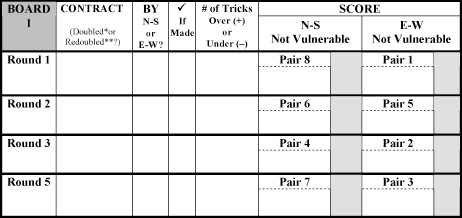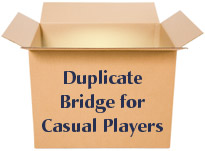Duplicate Bridge
How to Organize a Duplicate Bridge Group for Casual Players
For anybody who loves cards, bridge is too good a game to be left to the overly serious and sanctimonious bridge experts who so often populate our bridge groups. These guidelines are for people who enjoy the game but aren't experts. Our model was designed to meet the needs of a group of friends who had played bridge through college but not a lot since, who for the most part had never played duplicate bridge and who knew the conventions that were used in contract bridge 40 or 50 years ago but are no longer in practice.
Our Group: We meet at our house about every six weeks, 4 tables (16 players), each team rotating and playing 14 hands. People come at 7:00 and contribute wine and snacks. Between 7:00 and 7:30 we give a brief lesson, based on an interesting hand from the previous game, which is laid out with all hands exposed and copies of the scorecard for everyone. Play starts at 7:30.
Why Duplicate Rather than Contract Bridge: Duplicate bridge takes the "luck of the cards" out of the game, permits people to see how they are doing compared to others and compared to where they started and gives us a chance to learn from how four different teams played the same hand.
How to Get Started: Having never played duplicate bridge, we checked out a variety of books from the library to understand how duplicate works. There are some minor differences in scorekeeping, but they are easy to understand and don't differ much from contract bridge scorekeeping. The hardest part is to figure out how to move the teams around the room during the evening.
Bridge Refreshers: Unless your group has been playing a lot of bridge and is familiar with duplicate bridge, you should give new members of the group something to look at before the first evening. When we started our group several years ago, because it included some people who had never played, we put together two simple documents, "Bridge Basics" and "Duplicate Bridge." Click here for those documents. Having played for a while, we wouldn't do them exactly the same way today, but we found most bridge books to be too complex and daunting for new players. Over the years, our group has discovered Audrey Grant's books which are very clear and well designed. At a minimum, people should get her first book Bridge Basics and her little summary cheat sheet.
Finding your Players: We have an email list of about 30 people to fill the 16 spots we need for each game. This is critical to make sure you have enough players and can fill a spot when someone drops out at the last minute. This means recruiting everybody you know at the beginning to build your list. You'll have to convince people that this is not a game of expert bridge players and you are doing it to learn and have fun. Some of our first players had never played bridge at all. Many had not played for a long time. We made those early sessions learning sessions, encouraging table talk (we still encourage table talk). Our group includes close friends and casual acquaintances, couples and singles.
Pairing People Up: We create the pairs before each game and have name tags with the pair number and table and direction of their first round (Pair 5, Table 2, East-West) on each name tag. We keep a running tally of who played together at each prior game and also the range of scores from best to worst. We look for people who haven't played together recently and also try to match better scorers with worse scorers. Sometimes when people are new to the group, they request to play with a spouse and in that case we let them do so for a few evenings. Others refuse to play with a spouse. Over time folks have generally been happy to play wherever we put them.
Announcing a Game: As soon as we pick out a night for the next game (it's usually on a Friday), we send out an email to our distribution list with the upcoming date and letting them know that the first 16 people to sign up will get a place. We often have people who are late responding and we put them on the wait list, which is always helpful if someone drops out. Then a week before the game, we send a reminder email only to the 16 people signed up to play, urging them to let us know right away if their plans have changed. We've still had the rare last minute illness but generally have had enough people on the wait list or who didn't respond at all whom we can call on to fill in. Worst case you can move to 3½ tables with each pair sitting out for one round.
Paraphernalia: You have to buy the little plastic rectangular boards where the hands that are played can be reinserted into the board for the next team. They are available online and not expensive. You also need travelling scoreslips which you can read about online at various bridge sites. After trying a couple of preprinted versions and dealing with infinite scoring mistakes, we designed our own travelling scorecard which is a double entry system and a little harder to mess up than some. We print them out on pink paper and they get refolded and put back into the board after each hand.

Click here for a printable pdf.
Responsibilities at each Table: The person sitting North at each table is supposed to fill out the scorecard and the other team should check it. In our case, a lot of our players don't know how to keep score, so someone else can in that case substitute for North. South is supposed to keep track of making sure the two correct boards are on the table for this round.
What's on Each Table: Placed in the center of each table is a How to Keep Score sheet, a Direction Sheet containing the table number, the boards to be played on that table each round, where each of North, South, East and West should sit and where to go for the next hand (click here for a sample), and two boards stacked on top of each other, each containing the four hands and the travelling pink scoreslip (which you can't look at until you've played the hand). Extra boards not currently being played are kept on a side table.
Play of the Cards in Duplicate: Prior to the evening's game, each hand is shuffled and dealt and placed into one of the plastic boards. As the cards are played, instead of throwing them all into the middle with the winner pulling in the trick (as you would in contract bridge), each player places the card played on his side of the plastic board. At the end of the trick, each player takes back his card, putting it in a row from left to right along his edge of the table; if his team won the trick, that card is aligned vertically; if his team lost the trick, that card is aligned horizontally. So each player can look down at the line of face down cards in front of him and see how many tricks his team has and how many the other team has.
The Rotation: There are standard rotation routines you can find online or in duplicate bridge books, depending on the number of players/tables. We play 14 hands, with two hands each round and therefore a total of seven rounds. After the two boards are played and the scores calculated by North (and checked by the other pair) and entered on the pink scoreslip which is reinserted into the board, each team moves to the new location stated on the Direction Sheet in the middle of the table. After arriving at the new location, South should make sure the correct boards for that round are on the table. In the course of an evening, each of the eight pairs plays every other pair and each of the boards is played by all teams.
Announcing Results: Whoever finishes first (if there is a spouse there who is not playing, that person acts as scorekeeper) enters the scores onto a laptop as a board is finished, so the winners for the evening can be quickly calculated. We usually announce the top three teams before people leave that evening and periodically we'll send around an email with the overall top scorers. We don't publish the whole list.







